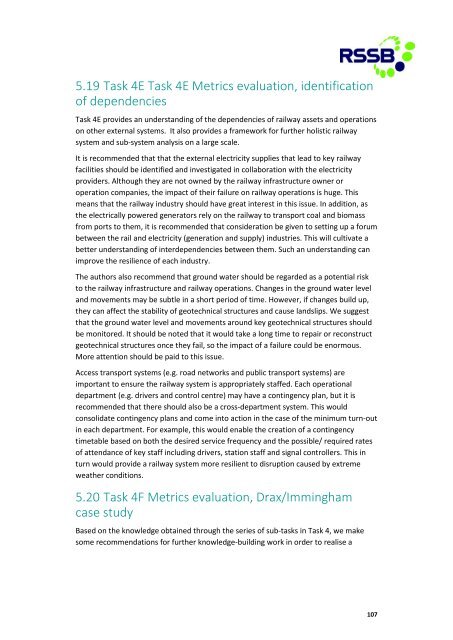Tomorrow's Railway and Climate Change Adaptation Final Report
2016-05-T1009-final-report
2016-05-T1009-final-report
Create successful ePaper yourself
Turn your PDF publications into a flip-book with our unique Google optimized e-Paper software.
5.19 Task 4E Task 4E Metrics evaluation, identification<br />
of dependencies<br />
Task 4E provides an underst<strong>and</strong>ing of the dependencies of railway assets <strong>and</strong> operations<br />
on other external systems. It also provides a framework for further holistic railway<br />
system <strong>and</strong> sub-system analysis on a large scale.<br />
It is recommended that that the external electricity supplies that lead to key railway<br />
facilities should be identified <strong>and</strong> investigated in collaboration with the electricity<br />
providers. Although they are not owned by the railway infrastructure owner or<br />
operation companies, the impact of their failure on railway operations is huge. This<br />
means that the railway industry should have great interest in this issue. In addition, as<br />
the electrically powered generators rely on the railway to transport coal <strong>and</strong> biomass<br />
from ports to them, it is recommended that consideration be given to setting up a forum<br />
between the rail <strong>and</strong> electricity (generation <strong>and</strong> supply) industries. This will cultivate a<br />
better underst<strong>and</strong>ing of interdependencies between them. Such an underst<strong>and</strong>ing can<br />
improve the resilience of each industry.<br />
The authors also recommend that ground water should be regarded as a potential risk<br />
to the railway infrastructure <strong>and</strong> railway operations. <strong>Change</strong>s in the ground water level<br />
<strong>and</strong> movements may be subtle in a short period of time. However, if changes build up,<br />
they can affect the stability of geotechnical structures <strong>and</strong> cause l<strong>and</strong>slips. We suggest<br />
that the ground water level <strong>and</strong> movements around key geotechnical structures should<br />
be monitored. It should be noted that it would take a long time to repair or reconstruct<br />
geotechnical structures once they fail, so the impact of a failure could be enormous.<br />
More attention should be paid to this issue.<br />
Access transport systems (e.g. road networks <strong>and</strong> public transport systems) are<br />
important to ensure the railway system is appropriately staffed. Each operational<br />
department (e.g. drivers <strong>and</strong> control centre) may have a contingency plan, but it is<br />
recommended that there should also be a cross-department system. This would<br />
consolidate contingency plans <strong>and</strong> come into action in the case of the minimum turn-out<br />
in each department. For example, this would enable the creation of a contingency<br />
timetable based on both the desired service frequency <strong>and</strong> the possible/ required rates<br />
of attendance of key staff including drivers, station staff <strong>and</strong> signal controllers. This in<br />
turn would provide a railway system more resilient to disruption caused by extreme<br />
weather conditions.<br />
5.20 Task 4F Metrics evaluation, Drax/Immingham<br />
case study<br />
Based on the knowledge obtained through the series of sub-tasks in Task 4, we make<br />
some recommendations for further knowledge-building work in order to realise a<br />
107


